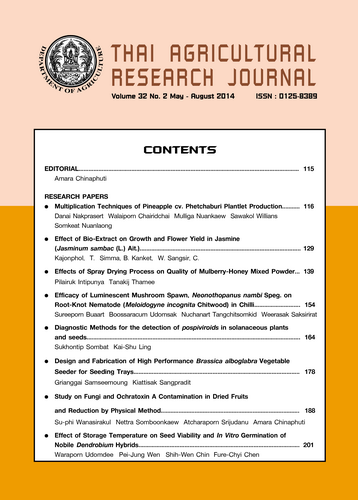Effects of Spray Drying Process on Quality of Mulberry-Honey Mixed Powder
DOI:
https://doi.org/10.14456/thaidoa-agres.2014.10Keywords:
maltodextrin, drying temperature, mulberry-honey mixed juice, spray dryingAbstract
Mulberry-honey mixed juice is not easy for spray drying because it is rich in sugar and organic acids. These low molecular weight components cause stickiness problem during drying. The aims of this research were to study the feasibility of drying mulberryhoney mixed juice using a spray dryer, effects of maltodextrin addition and drying temperature on the quality of the mixed juice powder. Powder’s quality changes during storage were also investigated. The experiment was conducted at Faculty of Agro- Industry,Chiang Mai University during April to September 2013. Spray drying of the mixed juice was conducted at three levels of solids in the mixed juice:maltodextrin ratio (1.0:1.1, 1.0:1.2 and 1.0:1.3) and three drying air temperatures (150, 160 and 170 °C) using a complete randomized design. It was found that by increasing the amount of maltodextrin, production yield increased. Moisture content and aw decreased, whereas moisture absorption increased. The suitable ratio of solids in mixed juice : maltodextrin was 1.0:1.3. Increased ofdrying air temperature expanded production yield but decreased moisture content and aw. Increasing drying air temperature also affected water absorption, solubility and dispersibility of the powder. Drying at 170 °C gave the highest yield of 24.92+0.57% and moisture content of 2.85+±0.09%. Reconstituted mulberry-honey mixed juice contained insignificantly lower total phenolic compound, total sugar and radical scavenging ability (p>0.05). Sensory acceptance scores for all attributes were not significantly different when compared between the reconstituted and freshly mixed samples. The sensory scores for the reconstituted sample ranged between “like” to “moderately like”. The quality of mulberry-honey mixed powder, vacuum packed in laminated aluminum bag stored at room temperature (28+3 °C) and 4 °C were insignificant (p>0.05) and safe from microorganisms after 12 weeks storage.
Downloads
Published
How to Cite
Issue
Section
License
Copyright (c) 2017 วารสารวิชาการเกษตร (Thai Agricultural Research Journal)

This work is licensed under a Creative Commons Attribution-NonCommercial-NoDerivatives 4.0 International License.
Thai Agricultural Research Journal



